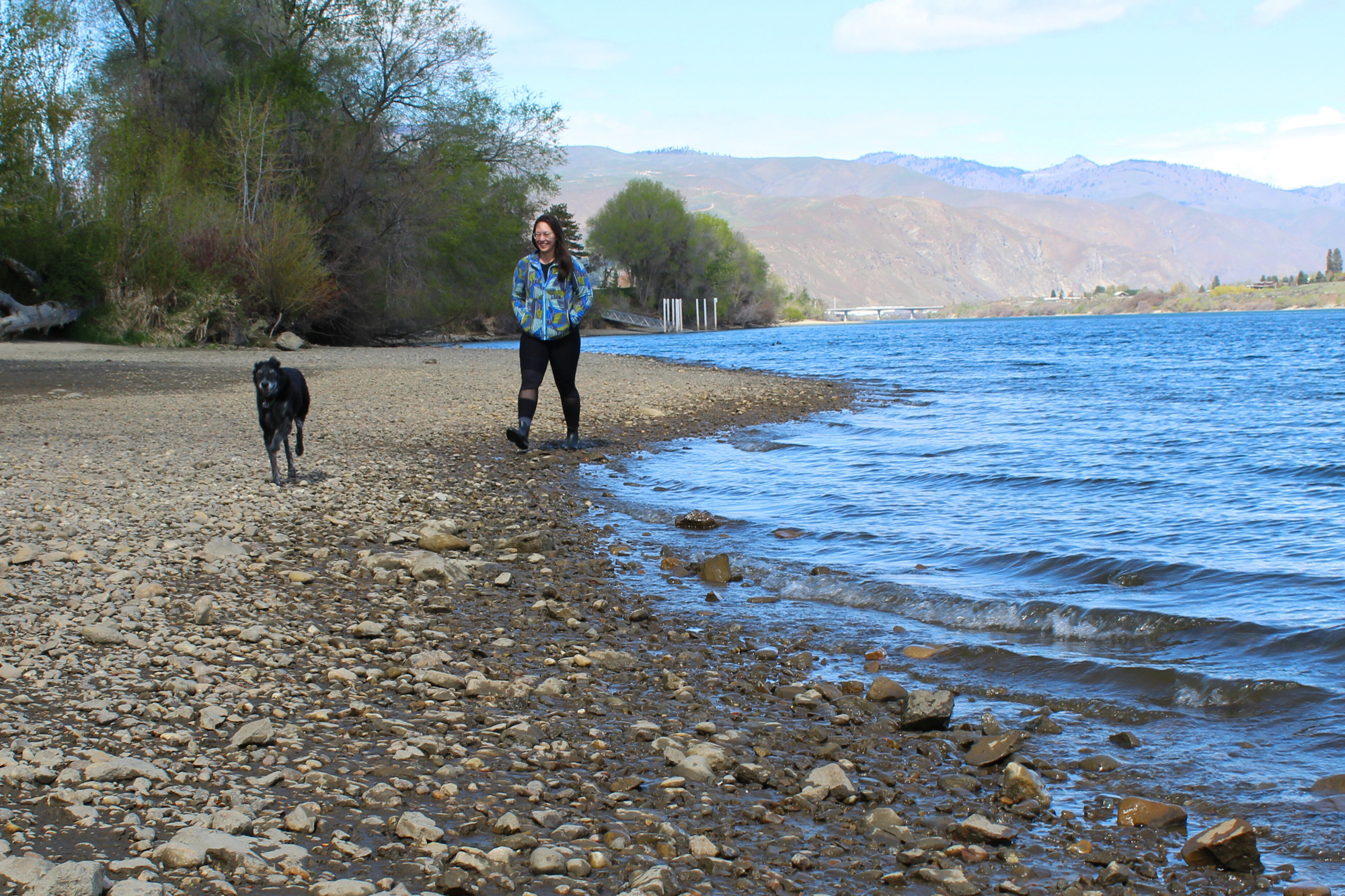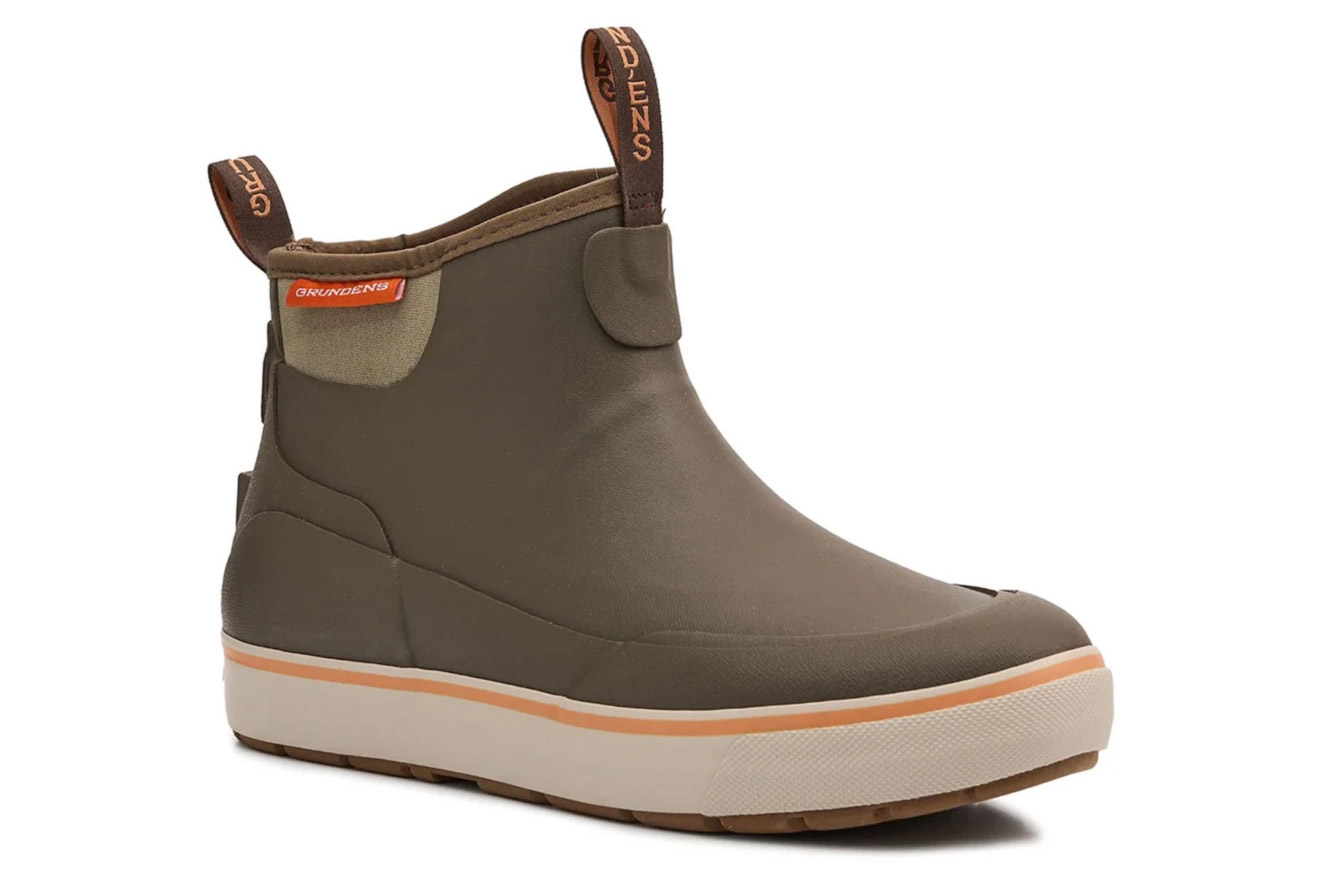From muddy trails to rainy errands and everywhere in between, a solid pair of women’s rain boots will keep you comfortable, stylish, and dry no matter what Nature throws your way this season. We’ve put 15 rain boots for women through the wringer over the past few years.
Our lead tester, Meg Carney, is no stranger to the importance of rain boots. She spent years working in muddy Midwestern outdoor conditions. Now, she lives in central Washington, where the rainy season (aka mud season) is long and sustained. She relies on waterproof rain boots for walking and hiking year-round, so she’s tested some of these boots for years, while others are new this season.
To rate performance, we took these boots hiking, wading through streams, and on daily chores during muddy, rainy days. We also subjected each model to a water immersion test, multiple hiking tests, and “slip tests” on wet terrain to see how they compared.
The Grundéns Deck Boss Ankle Boots earned our top spot because they’re comfortable, durable, and deliver unmatched traction on slippery trails or surfaces. If you’re looking for a stylish, waterproof option that’s a little easier on the wallet, consider our budget-friendly pick, the Asgard Ankle Rain Boots. No matter what you’re looking for in a rain boot, we have something for everyone.
Editor’s Note: We updated this buyer’s guide on May 17, 2025, with the addition of two new products: our pick for most stylish, the Blundstone Women’s Thermal Chelsea Boots, and the most comfortable we’ve tested, the Xtratuf 6″ Ankle Deck Boots.
The Best Rain Boots for Women of 2025
Top Picks
Most Stylish Performance Rain Boots for Women
Blundstone Women’s Thermal Chelsea Boots
8.7/10 RatingGrundéns Deck Boss Ankle Boots
- Sizes: 5-11
- Materials: Rubber, neoprene
- Weight: 1 lb., 11 oz.
- Mouth: 6”
- Insulation: No
Pros
- Comfortable for daily wear
- Neutral coloring pairs well with most outfits
- Durable and long-lasting
- Excellent traction on wet surfaces
- Wide toebox for added comfort
- Easy to slip on and off
Cons
- Boots rub some on the back of foot
Asgard Ankle Rain Boots
- Sizes: 5-13
- Materials: Rubber, EVA foam, PVC
- Weight: 1 lb., 8 oz.
- Mouth: 6.5”
- Insulation: No
Pros
- Stylish
- Excellent waterproofing
- Affordable price
- Easy to pull on
- Traction is surprisingly slip-proof
Cons
- Not very durable
- Narrow toebox
XTRATUF Salmon Sisters 15-inch Legacy Boots
- Sizes: 6-11
- Materials: Rubber, neoprene
- Weight: 5 lbs., 5 oz.
- Mouth: 11”
- Insulation: No
Pros
- Fit wide feet well
- Roll-down design adds to versatility
- Waterproof and acid chemical resistant
- Flexible materials and roll-down shaft
- Excellent traction
Cons
- No half sizes
- Lack of insulation
Blundstone Women’s Thermal Chelsea Boots
- Sizes: 6-11
- Materials: Waterproof leather, sheepskin footbed
- Weight: N/A
- Mouth: 11”
- Insulation: Yes
Pros
- Extremely waterproof and warm
- Durable build
- Slip-resistant outsole
- Easy pull-on design
- Stylish and versatile—can be worn casually or dressed up
- Low maintenance/leather resists stains
Cons
- Pricey
- Slightly heavy
XTRATUF Women’s 6″ Ankle Deck Boots
- Sizes: 5-11
- Materials: Rubber/neoprene
- Weight: 2 lbs. 8 oz
- Mouth: N/A
- Insulation: No
Pros
- Keep feet dry in rain, mud, and wet environments
- Lightweight and flexible—comfortable for all-day wear
- Excellent traction
- Easy pull-on design
- Supportive cushioning
- Durable and abrasion-resistant
- Stylish design/variety of colors
Cons
- No insulation
- Run large
More Rain Boots Great for Splashing Around
- Sizes: 6-11
- Materials: algae-based EVA footbed, rubber
- Weight: 14 oz.
- Mouth: 11.5”
- Insulation: No
Pros
- Super cute
- Easy pull-on handles
- Great for wide feet or thick socks
- Lightweight (not clunky)
- Great for short, fast trips outdoors
Cons
- Materials not suitable for working conditions
- Lacks cushioning for standing on hard surfaces
- Handles can allow some water into the boot
- Sizes: 5-11
- Materials: Rubber, 5mm CR Flex-Foam neoprene, EVA midsole
- Weight: 1 lb., 7 oz.
- Mouth: 14.6”
- Insulation: Fleece lining
Pros
- Suitable for temperatures ranging from -40°F to 40°F
- Durable construction
- Comfortable for all-day wear
- Excellent traction
- Perfect winter work boot
Cons
- Can easily get too warm
- High price
- Bulky
- Sizes: 6-12
- Materials: Algae-based EVA footbed, rubber
- Weight: 2 lbs., 14 oz.
- Mouth: 10.3”
- Insulation: No
Pros
- Stylish
- True to size
- Good traction control on wet surfaces
- Effective odor resistance
Cons
- Narrow fit
- Not good for walking long distances
- Sizes: 6-11
- Materials: Rubber, polyester cotton blend lining
- Weight: 1 lb., 10 oz.
- Mouth: 15”
- Insulation: No
Pros
- Affordable price
- Durable rubber
- Functional side buckle
- Fun and colorful
Cons
- Not very warm
- Not the best for wide feet
- Sizes: 6-11
- Materials: Phthalate-free synthetic rubber
- Weight: 2 lbs, 11 oz.
- Mouth: 14.2”
- Insulation: No
Pros
- Budget-friendly
- Effective waterproofing
- Several color options
- Up to 100% recyclable materials
- Reflective elements for nighttime visibility
Cons
- Not suitable for extended wear or rugged terrain
- Traction slips on slimy rocks
- Somewhat narrow fit
Rain Boots for Women Comparison Chart
| Rain Boots | Price | Sizes | Materials | Weight | Insulation |
|---|---|---|---|---|---|
| Grundéns W’s Deck Boss Ankle Boots | $110 | 5-11 | Rubber, neoprene | 1 lb., 11 oz. | No |
| Asgard Ankle Rain Boots | $30 | 5-13 | Rubber, EVA foam, PVC | 1 lb., 8 oz. | No |
| XTRATUF Salmon Sisters 15-inch Legacy Boots | $160 | 6-11 | Rubber, neoprene | 5 lbs., 5 oz. | No |
| Blundstone Women’s Thermal Chelsea Boots | $230 | 6-11 | Waterproof leather, sheepskin footbed | N/A | Yes |
| XTRATUF Women’s 6″ Ankle Deck Boots | $115 | 5-11 | Rubber/neoprene | 2 lbs. 8 oz | No |
| BOGS Floral Rain Boots | $75 | 6-11 | Algae-based EVA footbed, rubber | 14 oz. | No |
| Muck Arctic Sport II MID Boot | $160 | 5-11 | Rubber, 5 mm CR Flex-Foam neoprene, EVA midsole | 1 lb., 7 oz. | Yes |
| BOGS Holly Chelsea Rain Boots | $90 | 6-12 | Algae-based EVA footbed, rubber | 2 lbs., 14 oz. | No |
| Western Chief Garden Play Tall Rain Boots | $40 | 6-11 | Rubber, polyester cotton blend lining | 1 lb., 10 oz. | No |
| Kamik Heidi 2 Rain Boots | $60 | 6-11 | Phthalate-free synthetic rubber | 2 lbs, 11 oz. | No |
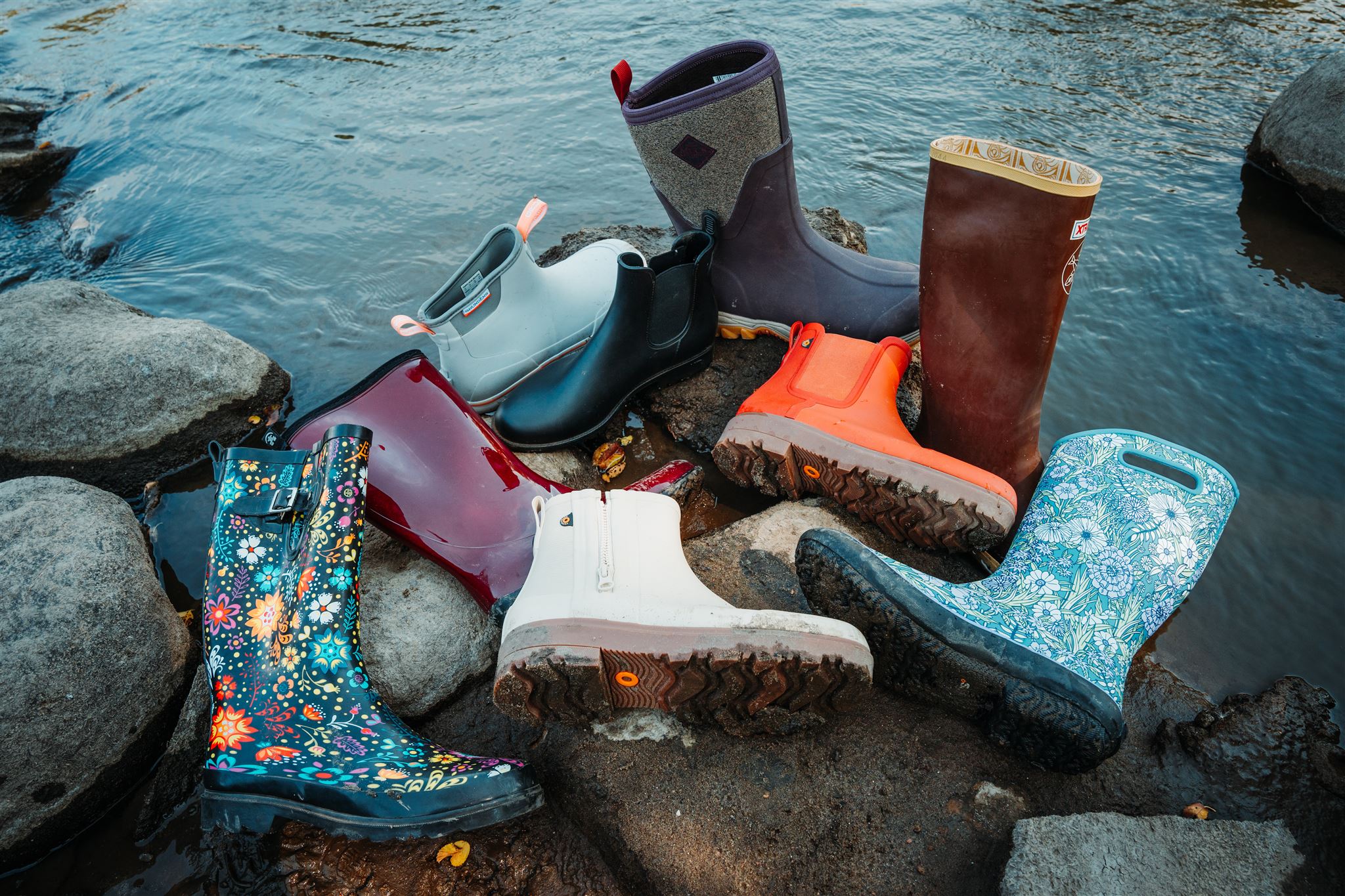
How We Tested the Best Rain Boots for Women
Our Expert Testers
To find the best rain boots for women, we conducted comprehensive testing to assess various features and provide accurate and reliable recommendations. Our lead tester, Meg Carney, grew up in the rural Midwest, which means a good, sturdy pair of rain boots was a must for her for a long time. She’s owned some boots on our list for five-plus years, and they’re still going strong, providing an excellent testament to their durability.
For boots new to her, she conducted testing over the course of a couple of months. To help get a more objective view of how the boots compared, she enlisted the help of a secondary tester of the same shoe size. They tested the boots during daily wear around town, doing yard work, and on multiple hikes where they walked on flat wet surfaces, rocky terrain, and within streams of moving water. Throughout the month, they were able to do some primary tests together, but the rest of the time, they wore different boots for each activity, swapped boots, and compared notes.
In 2025, Editor Chris Kassar took over testing, putting rain boots to the test in Grand Teton and Yellowstone National Parks, where she regularly wades through muck, streams, rivers, and creekbeds searching for wildlife and solitude.

Testing Process
Our testing process involved several key steps to evaluate the performance and suitability of different rain boot models.
Waterproofing: We subjected the rain boots to simulated rain conditions and immersion in water to check for any signs of leakage or water penetration and determine their effectiveness in keeping feet dry.
Comfort/Fit: By wearing the boots for extended periods and walking on different surfaces, we noted cushioned insoles, adjustable closures, and ergonomic designs that enhance comfort and support.
Traction: To assess grip and stability, each boot was put to the test by walking on wet, slippery surfaces that included mud, rocks, and other potential hazards.
Durability: WE examined the rain boots’ materials, construction, and overall build quality to ensure they could withstand regular wear and tear over time.
The testing process focused on evaluating waterproofing, comfort, traction, and durability to provide comprehensive insights into the performance of women’s rain boots. Though some of these rain boots work well for hiking, if you’re looking for recommendations for more specific boots, check out our guide to the Best Hiking Boots for Women. If you’ll be mucking around in the water in warmer seasons, check out our guide to the Best Water Shoes for Women. And, if you’re looking for boots to keep the guys in your life dry, check out our guide to the Best Rain Boots.

Buyer’s Guide: How to Choose the Best Rain Boots for Women
When selecting the perfect pair of women’s rain boots, several features should be considered, including waterproof materials, durable construction, proper fit, and traction-enhancing outsoles.
Materials and Durability
Many of the best rain boots use waterproof materials like rubber, PVC, or neoprene, known for effectively repelling water. While neoprene offers waterproof properties, its production relies on petroleum, emits carbon dioxide, and lacks biodegradability.
Other common rain boot materials also pose environmental challenges. PVC, though recyclable, may release dioxins and contain phthalates, while rubber sourcing can be environmentally destructive.
For environmentally conscious consumers, longevity becomes paramount. Our XTRATUF Rain Boots and Muck Arctic Sports have lasted upward of 5 years with no signs of stopping, and our Grundéns Ankle Boots have withstood three years of near-daily wear in the shoulder and winter seasons.
The best option is to maximize the lifespan of your rain boots since these materials are hard to avoid. Wear them for as long as possible, maintain them, and avoid replacing them unless necessary. Durability is a key focus in our testing processes, emphasizing the importance of investing in boots built to last.
Certain areas of rain boots are more prone to damage or wear much faster than others. Seams, for instance, are among the most common points of failure in rain boots. Keep boots in good working condition by inspecting the seams and bonding methods used in the boots’ construction.
Heat-sealed or vulcanized seams offer superior durability compared to glued seams, so while shopping, it can help to look for these features. Additionally, check for reinforced areas like the toe cap and heel, which are prone to wear and tear over time.
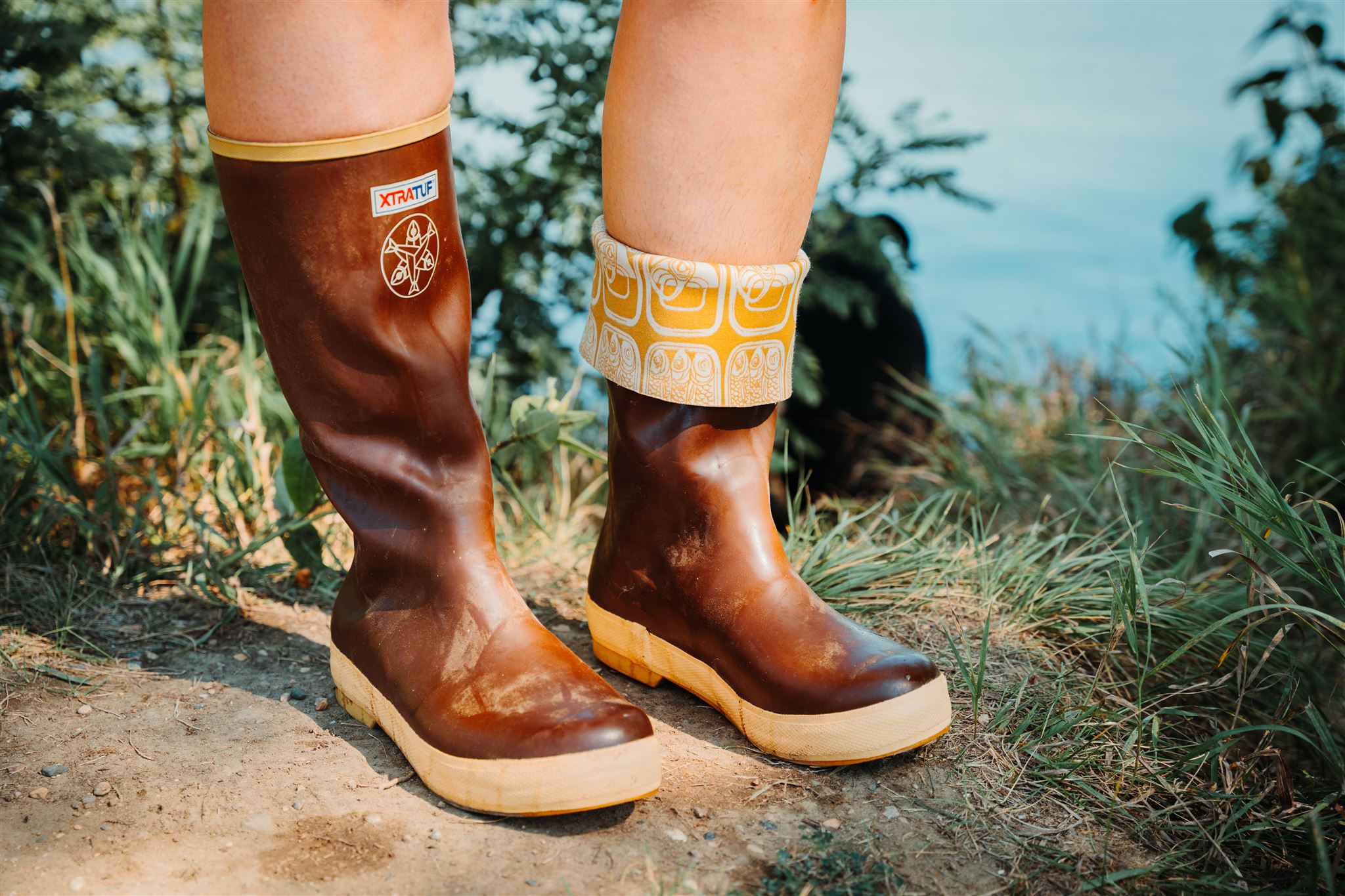
Consider the outsole design and material. Look for rain boots with durable rubber outsoles featuring deep treads or lug patterns. By carefully examining materials and durability features, you can identify the best rain boots for women with long-lasting performance and reliable protection.
Breathability
When analyzing the breathability of rain boots, consider comfort and find ways to prevent moisture buildup inside the boots. It is important to note that quality rain boots are made from solid materials that typically don’t allow much airflow through the materials. Still, you can look for breathable linings that allow air circulation while effectively wicking away sweat and moisture from the feet.
A proper fit with enough room for air circulation can also enhance breathability. Avoid overly tight or constrictive boots that may restrict airflow and lead to discomfort. Since finding a “breathable” rain boot is near impossible, we look at other aspects related to breathability, like odor resistance.
Most BOGS rain boots, like the Floral Rain Boots featured as our favorite classic rain boots, are made using DuraFresh natural biotechnology to combat odors and prevent the growth of bacteria.
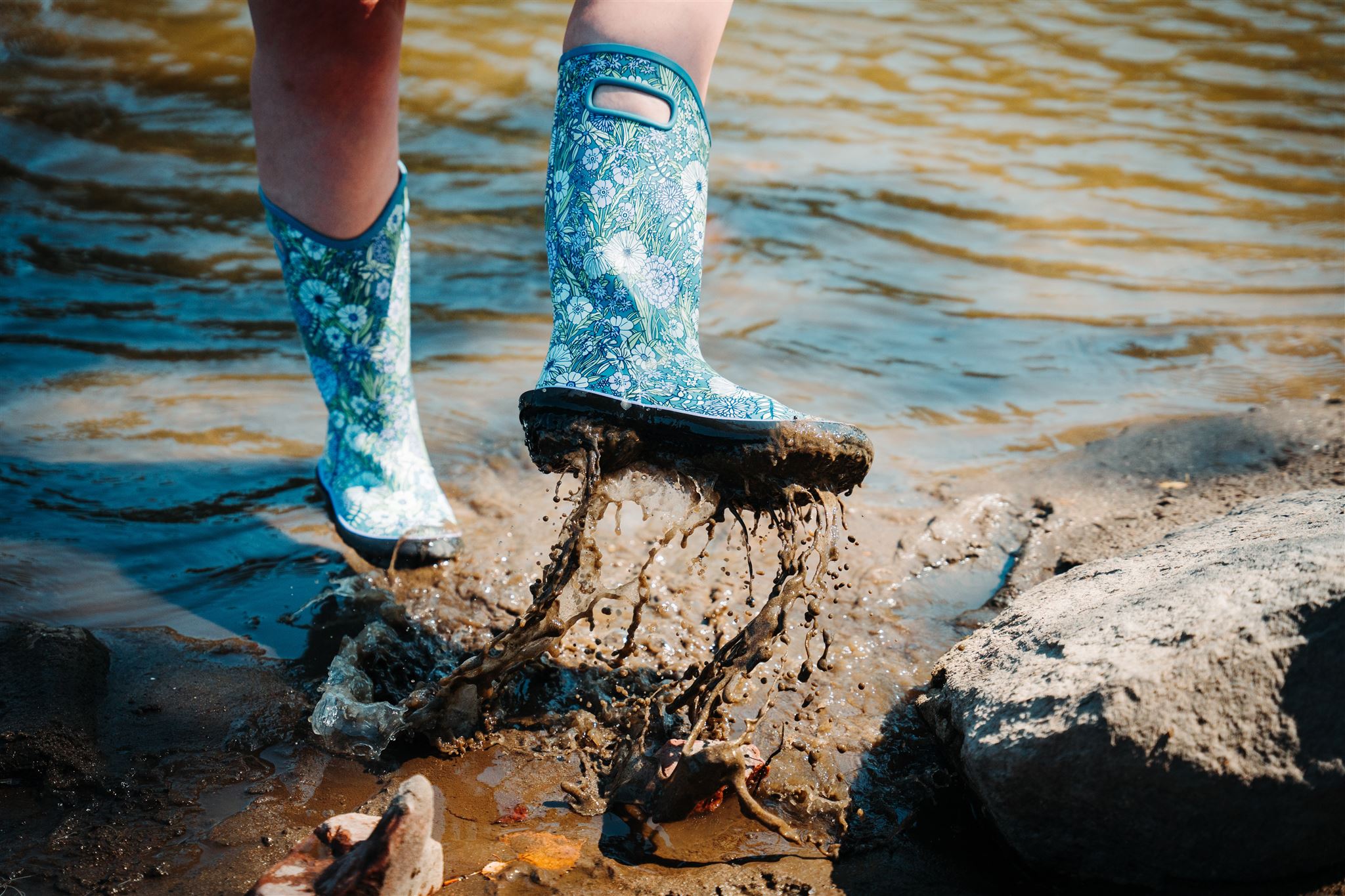
Comfort and Fit
Look for soft, flexible, and lightweight materials that provide a comfortable fit without causing discomfort or chafing. Cushioned insoles or footbeds like those found in our pick for most comfortable, the XTRATUF Women’s 6″ Ankle Deck Boots, can provide support and shock absorption, and anatomically shaped footbeds or contoured arch support can also enhance comfort.
Finding rain boots that fit correctly helps provide enough room for your toes to wiggle, and the materials don’t pinch or rub against your feet. We might prefer a boot like the Grundéns Deck Boss Ankle Boots over the Asgard Ankle Boots because they have a wider toe box and better cushioning for extended wear.

Here are some tips for finding rain boots that fit:
Measure Feet: Measure the length and width of your feet. Refer to size charts provided by rain boot manufacturers to determine the appropriate size for you.
Consider Sock Thickness: If you plan to wear thick socks with your rain boots, consider their thickness when selecting the size, and try boots on with the socks you plan to wear. You may need to size up to accommodate thicker socks.
Check Toe Room and Width: There should be enough room in the toebox for your toes to wiggle comfortably, as we experienced in the BOGS Floral Rain Boots. Your toes should not feel cramped or squeezed against the front of the boots.
Consider Calf Circumference: If you have wider calves, look for rain boots with adjustable gussets or wider shafts to accommodate your calf size.
By following these tips and ensuring a proper fit, you can find rain boots that are comfortable to wear for daily wear, work, or rainy-day dog walks.
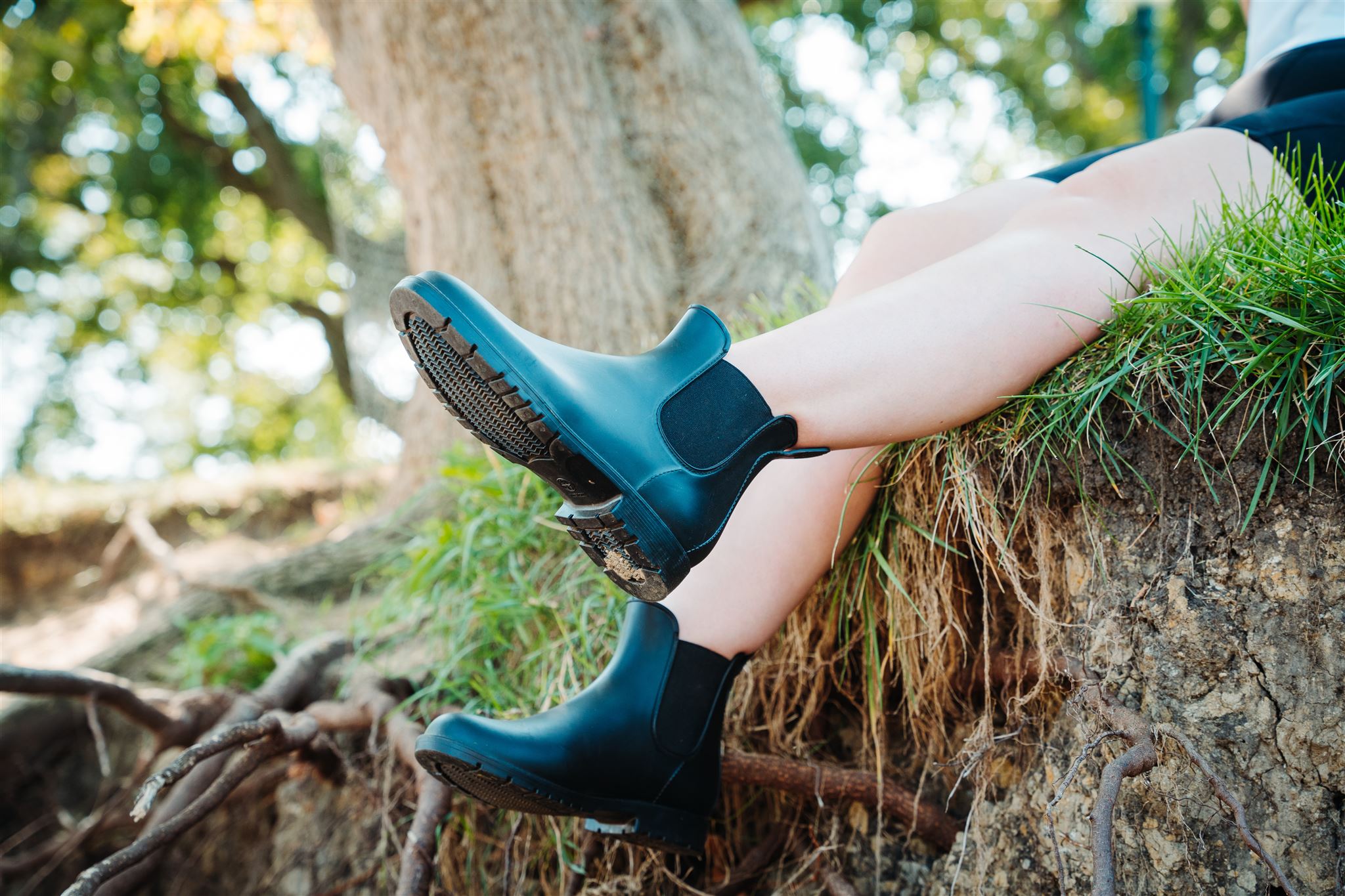
Insulation
Insulated rain boots are not necessary for all users. If you are someone who lives in a colder climate, having insulated rain boots, like the Blundstone Women’s Thermal Chelsea Boots or Muck Arctic Sport, is an excellent option for winter wear. For standard daily wear when insulation is less of a priority, you may want to try the Kamik Heidi 2 Rain Boots. But, pay attention to the linings and inner materials to better understand the insulating properties.
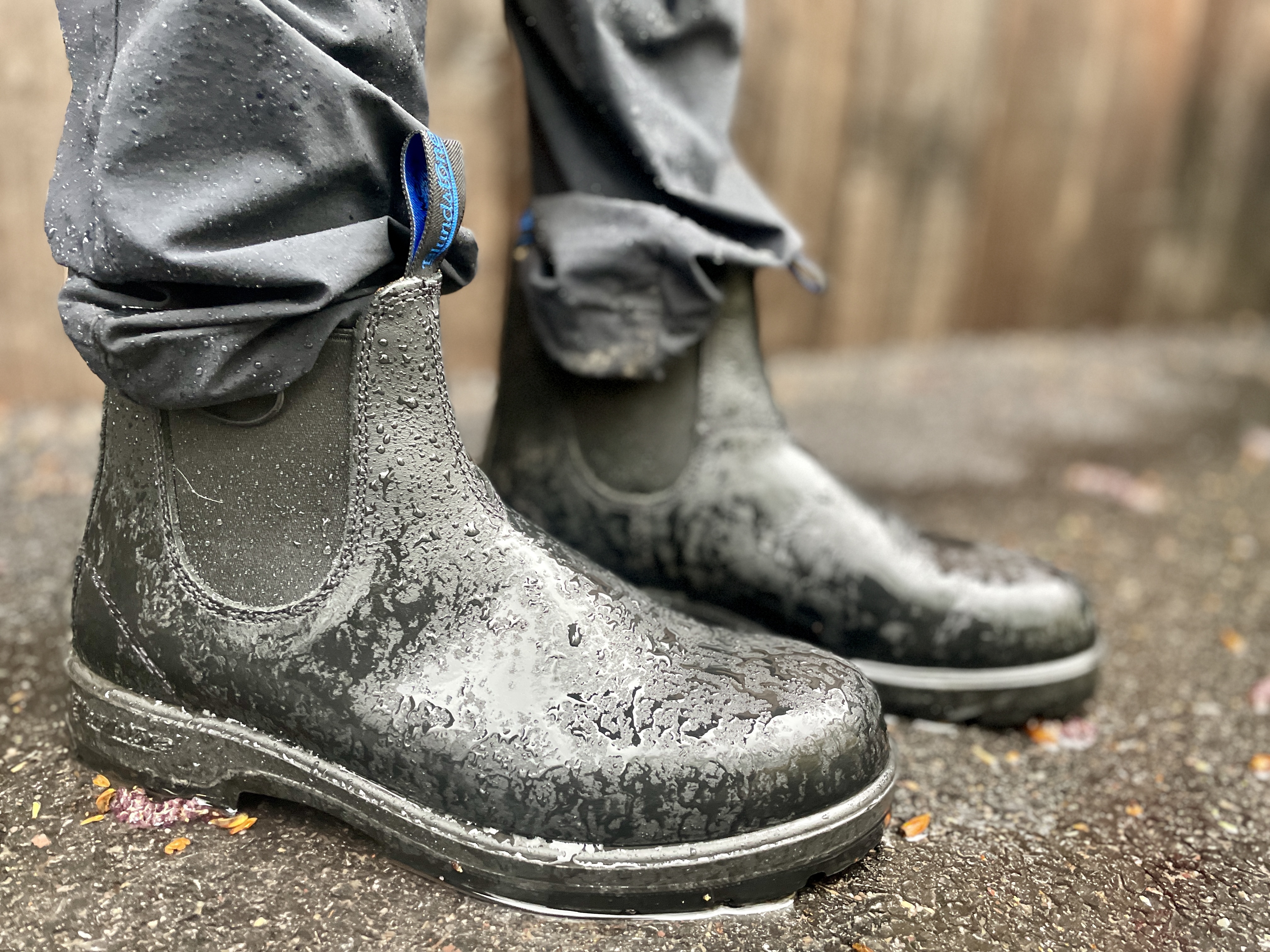
Materials like neoprene or rubber offer better thermal protection against cold temperatures. Rain boots with an insulated lining, such as fleece or synthetic materials like Thinsulate, provide warmth by trapping body heat inside the boots. Taller shafts, like the XTRATUF 15″ boots, cover more of the leg, providing additional insulation and protection from cold weather.
Some rain boots feature removable liners that can be added or removed based on temperature conditions, allowing for customizable insulation. If you’re looking for winter-specific hiking boots, check out our Best Winter Hiking Boots guide.
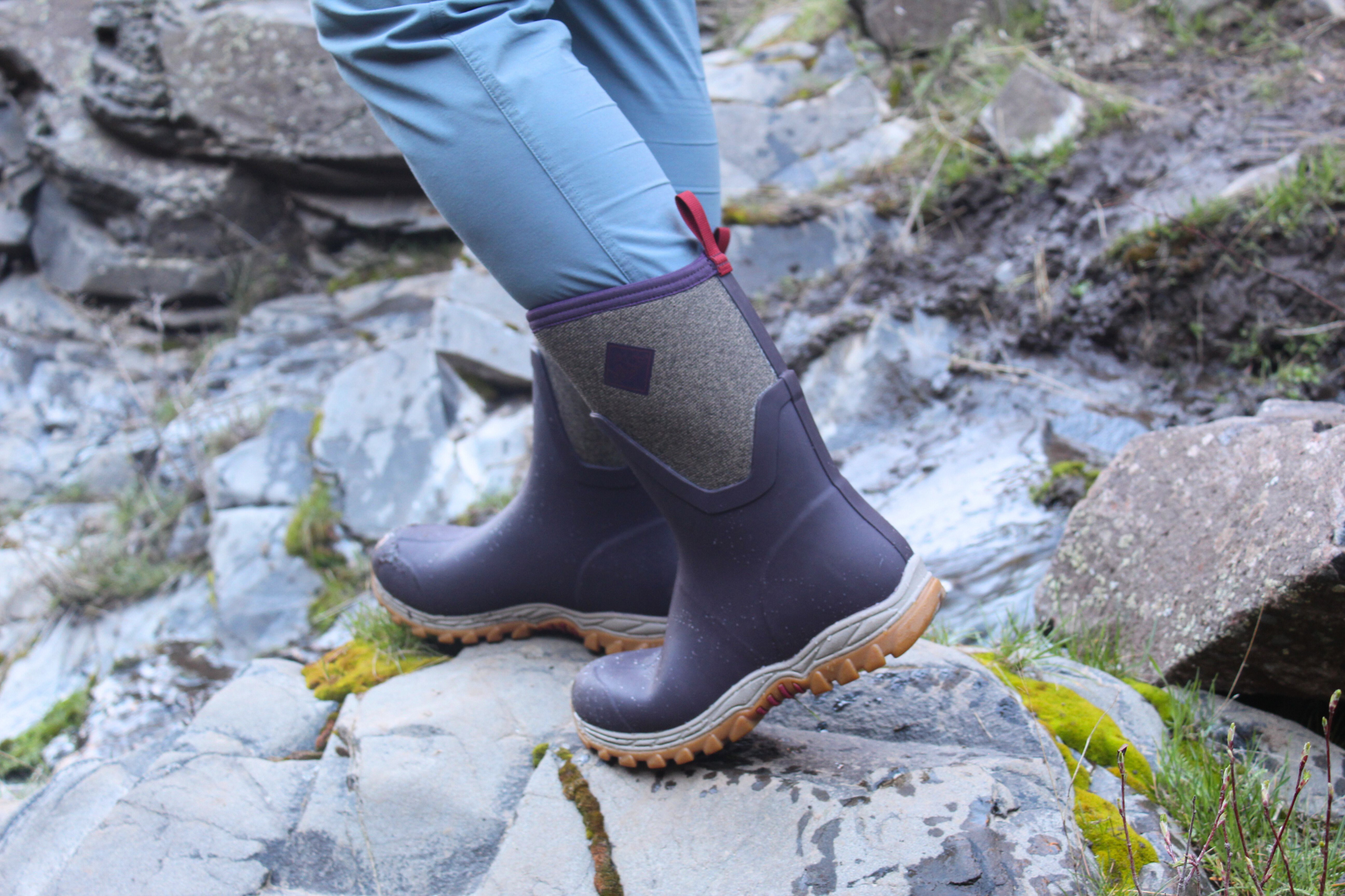
Traction
Even just walking around town, if you’re wearing rain boots, it is likely wet, muddy, or even a little bit icy. In those conditions, you need a pair of boots with adequate traction. When choosing rain boots with good traction, consider the following factors:
Outsole Design: Look for rain boots with outsoles featuring deep treads and lug patterns or specific slip-resistant grips, like the Grundéns Deck Boss Ankle Boots or XTRATUF Women’s 6″ Ankle Deck Boots. These designs provide better grip and traction on wet, slippery surfaces.
Material: Rubber outsoles offer excellent traction on wet surfaces, providing a firm grip and resistance to slipping.
Lug Depth: Lug depth refers to the height or depth of the tread patterns on the outsole of a shoe or boot. These patterns typically consist of raised, ridged, or grooved sections that provide traction and grip.
A few brands known for offering rain boots with excellent traction include BOGS, Muck Boots, and XTRATUF. Fishermen and outdoor enthusiasts favor the XTRATUF Rain Boots for their slip-resistant outsoles, which offer reliable traction on wet decks and slippery surfaces. If you’re ever in Alaska, you’ll notice it is a trendy brand up there.
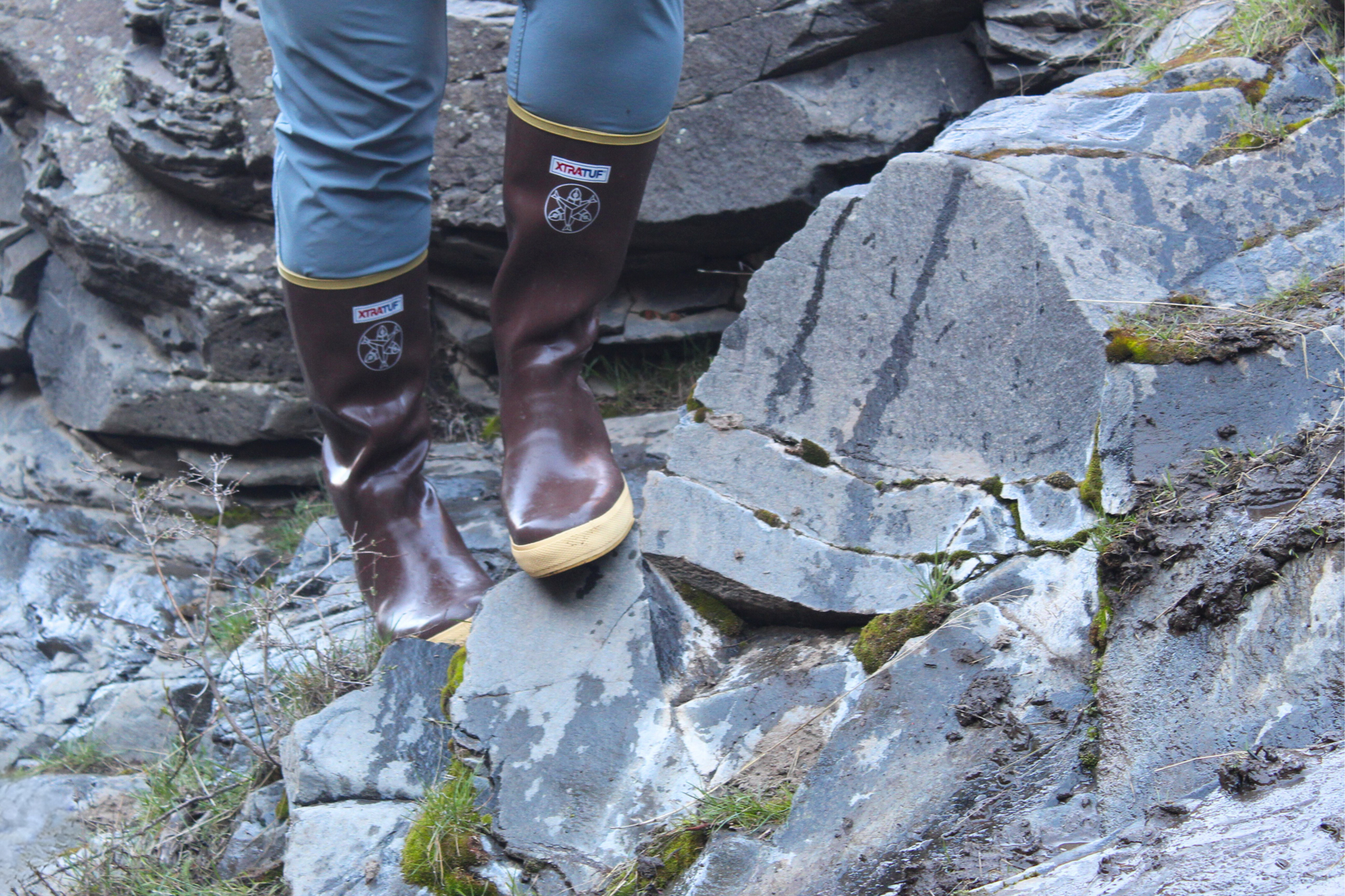
Height and Style
Choosing the best height and style of rain boots depends on personal preference, intended use, and practicality. Knowing the options available to you and identifying their intended purpose is a good place to start.
There are three standard rain boot heights:
- Ankle-height rain boots offer ease of mobility and are suitable for casual wear or urban settings.
- Mid-calf rain boots provide more coverage and protection against splashes and puddles. They are versatile and suitable for both urban and outdoor activities.
- Knee-high rain boots offer maximum coverage and protection and are ideal for heavy rain, deep puddles, or outdoor activities like gardening or hiking.
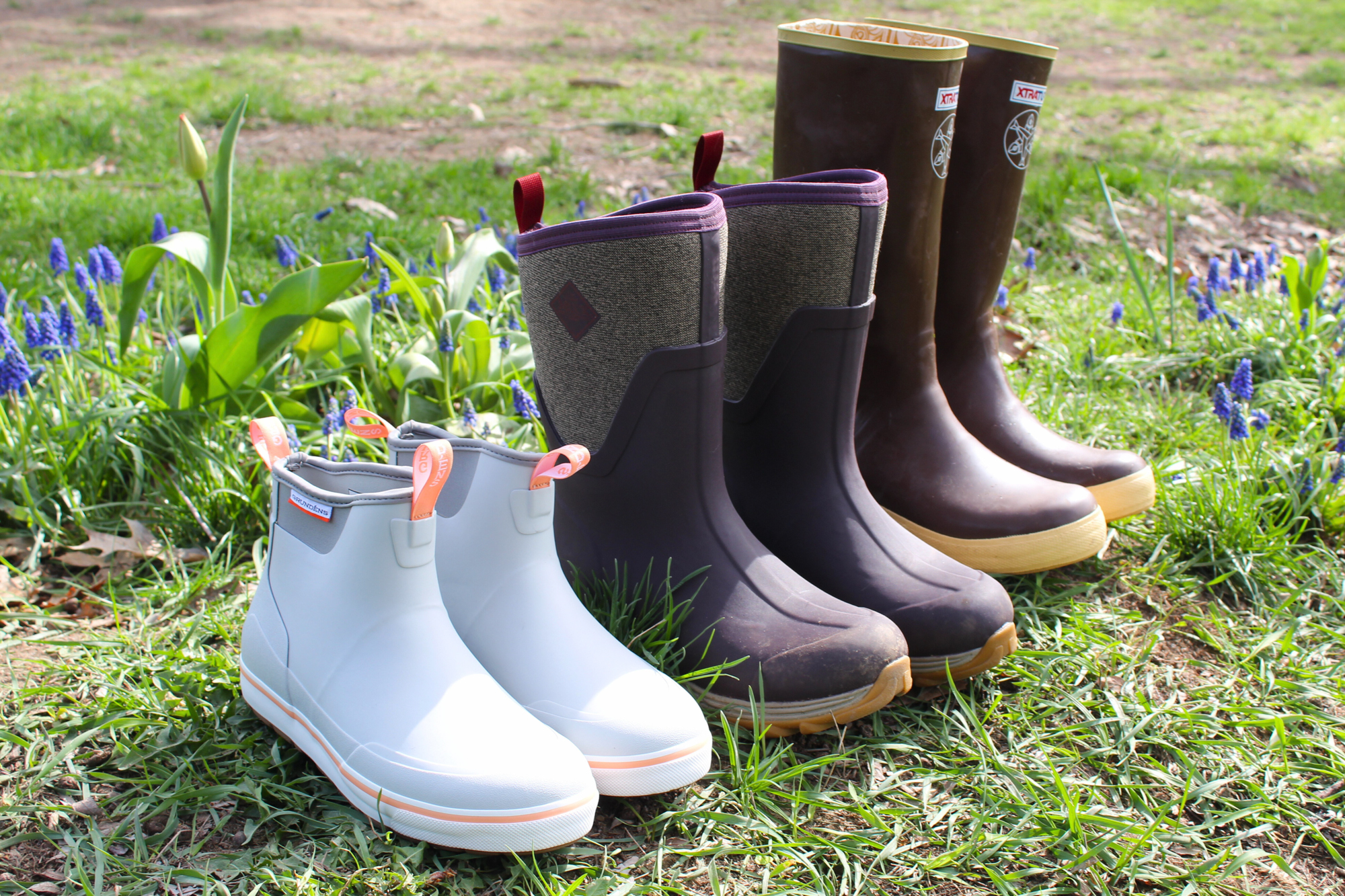
For everyday wear, look for versatile styles and a height that can transition between activities. We often choose ankle-high boots like Grundéns Deck Boots for daily wear, especially in the spring. Or, if we need a boot that can go from an office meeting to an adventure, we choose the Blundstone Women’s Thermal Chelsea Boots.
Taller rain boots that offer more durability and protection may be desirable for outdoor activities. XTRATUF and Muck Boots are popular options when seeking boots for gardening, outdoor work, or daily chores.
Beyond height, style may be a factor. The three most common styles of rain boots include:
- Classic rain boot styles like the Western Chief Rain Boots feature a variety of colors or patterns, offering timeless appeal and versatility.
- Fashion rain boots come in trendy designs, colors, and patterns, allowing you to make a fashion statement or blend in seamlessly with daily workwear like the Kamik Heidi 2 Rain Boots.
- Functional rain boots prioritize practicality and performance, with features like adjustable straps, reinforced toes, or insulated linings for added functionality.
Ultimately, choose rain boots that reflect your style preferences and lifestyle while meeting your practical requirements for comfort, functionality, and protection.

Price & Value
Rain boots can vary widely in price. The boots we’ve tested start around $30 but can cost up to $160. Determining how much to pay for rain boots will depend largely on how you plan to use them and how often.
Budget
You’ll find options like the Asgard Ankle Rain Boots ($30) and Western Chief Garden Play Tall Rain Boots ($35) in the budget range, which spans $30 to $60. Both offer effective waterproofing and stylish designs ideal for casual or urban wear.
However, expect to sacrifice some durability and support at a lower price point. The Asgard boots are the most narrow and least suited for rocky terrain. The Western Chief boots are comfortable but are made with a flimsy and less durable material, shortening their lifespan.
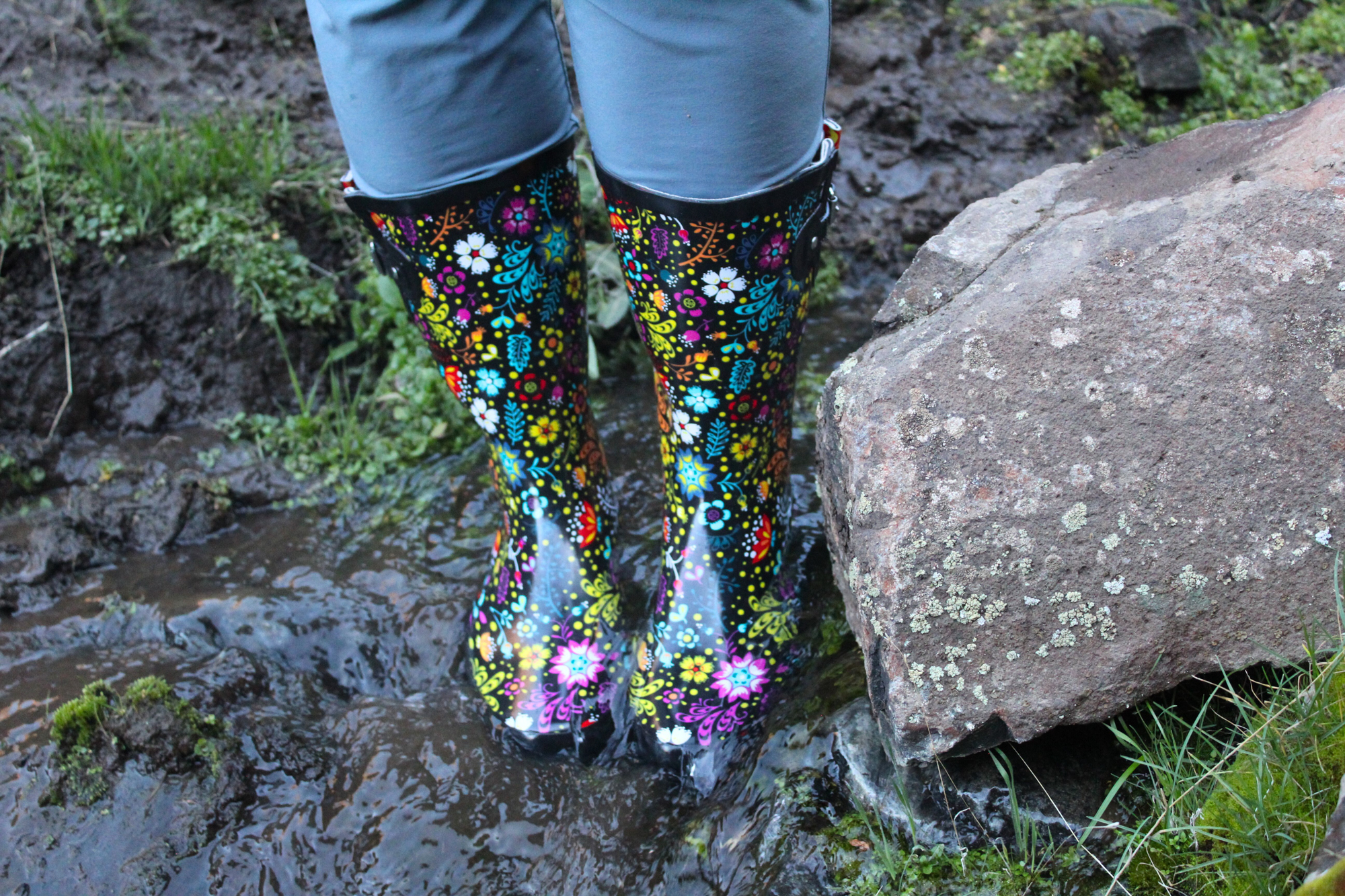
Mid-Tier
The BOGS Vintage Floral Rain Boots ($75), Grundéns W’s Deck Boss Ankle Boots ($110), and XTRATUF Women’s 6″ Ankle Deck Boots are solid mid-tier options ($75-120). They provide a significant step up in comfort and functionality compared to budget picks.
The BOGS Floral boots feature a lightweight design and great aesthetics, perfect for short trips, while the Grundéns and XTRATUFs offer stunning durability and traction for more versatile wear. Although you gain better materials and support, you still miss out on features like insulation, sometimes found in premium options.
Premium
For those willing to invest in a premium boot ($130-235), the Muck Arctic Sport II MID Boot ($140) and XTRATUF Salmon Sisters 15-inch Legacy Boots ($160) are necessary for the most rugged cold and wet conditions. You’ll be hard-pressed to find boots that outperform these.
The Muck boots offer exceptional insulation, comfort for all-day wear, and optimal traction on slippery surfaces. The XTRATUF Legacy Boots are a common sight in climates like Alaska, speaking to their functionality and durability. We feel the extra cost is justified, especially for serious outdoor work or extreme weather. Similarly, the Blundstone Women’s Thermal Chelsea Boots ($235) deliver a versatility that others lack since they can easily move from the trail to town and back again while also delivering high-performance weather-proofing.
Frequently Asked Questions
Rain boots are suitable for everyday wear, especially in regions with frequent rainfall or wet weather conditions. They provide waterproof protection, keeping your feet dry and comfortable during daily activities such as commuting, running errands, or walking the dog.
Rain boots come in versatile styles, designs, and heights, allowing you to match them with different outfits for versatile everyday wear. Modern rain boot designs offer improved comfort features like cushioned insoles or insulation, making them suitable for prolonged daily wear.
Ankle boots like Grundéns W’s Deck Boss Ankle Boots offer a balance of versatility, comfort, and protection, making them ideal for daily wear and activities.
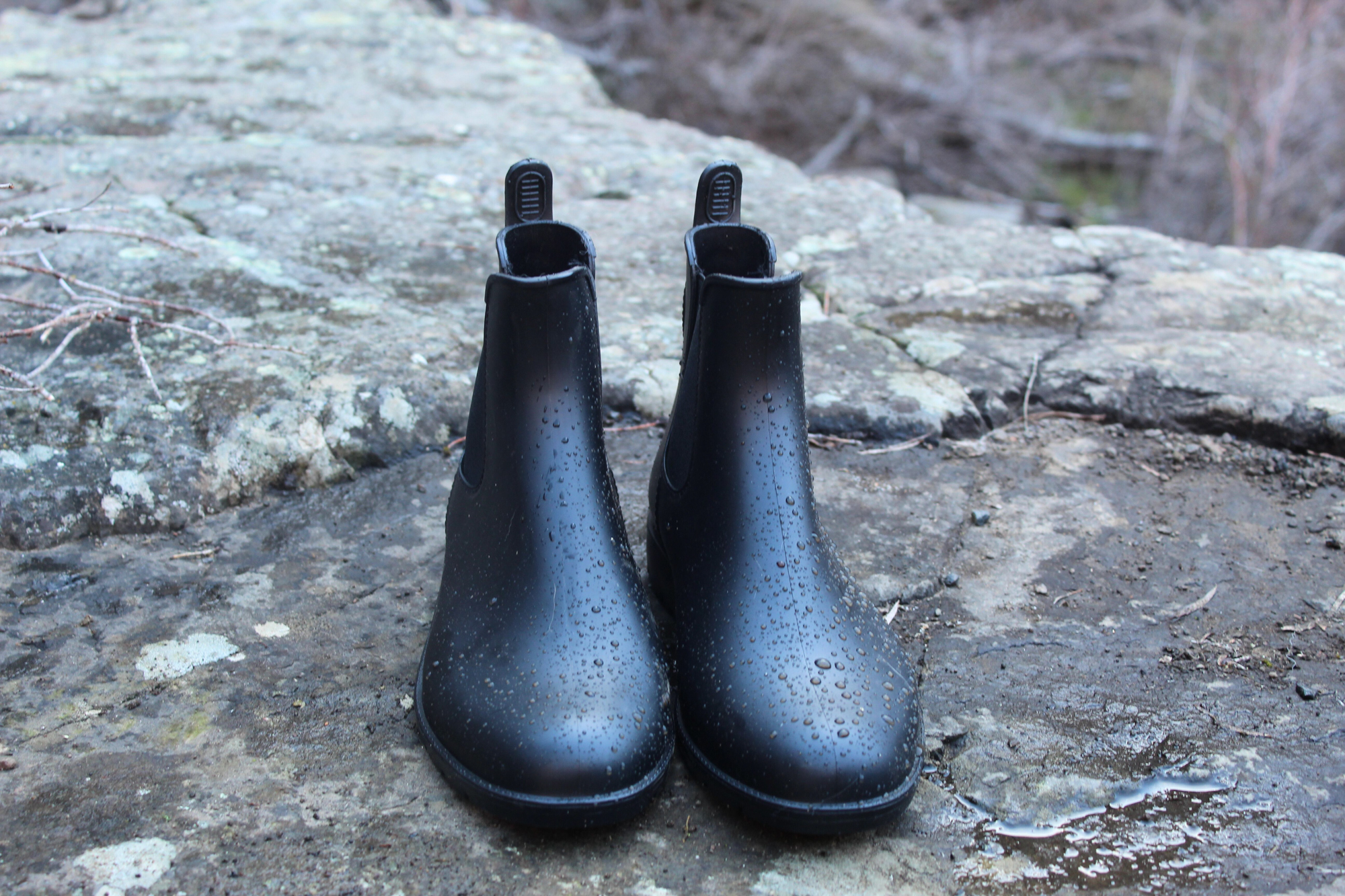
Sometimes, it may be advisable to size up, especially if you wear thick socks or liners with your rain boots for added warmth or comfort. Sizing up can accommodate differences in foot width or shape, providing a more comfortable fit. Consider the sizing recommendations offered by the manufacturer, and whenever possible, try the boots on in person.
Trying on the rain boots with the socks you intend to wear can also help determine the best size. Ultimately, the decision to size up should be based on personal comfort and fit preferences to ensure a satisfactory wearing experience.
Whether pants should go over or under rain boots depends on personal preference and the style of the rain boots. Tucking pants into rain boots can help prevent water from entering the boots and keep your pants drier. This method works well with taller rain boots or when wearing skinny jeans or leggings.
You may prefer to wear pants over rain boots for a more streamlined look or if the pants are wider or flared. This style is more common with shorter rain boots or when wearing bootcut or wide-leg pants. Check out our guide to Best Hiking Pants for Women to find the best pants for your specific needs.
To prevent water from getting into rain boots, you can take several measures:
- Rain boots should fit snugly around your calves and ankles to minimize gaps where water can enter.
- Tuck pants into boots to create a barrier that prevents water from seeping in from the top.
- Consider wearing rain pants.
- Wear boot liners or waterproof socks inside your rain boots to absorb moisture.
- If your rain boots have adjustable straps or closures, tighten them properly to seal out water.
- Be mindful of where you walk and avoid stepping into deep puddles or bodies of water that could overflow into your boots.
- Inspect your rain boots regularly for any cracks, holes, or damage that could compromise their waterproofing ability.
Muck boots and rain boots are similar in that they both offer waterproof protection for your feet in wet conditions. However, they are not exactly the same.
Muck boots are designed for outdoor activities such as farming, gardening, or hunting. They are made with more durable materials for added protection against mud, muck, and other harsh conditions. They typically feature a higher shaft and insulation for warmth, making them suitable for colder temperatures.
Rain boots are more versatile and can be worn for everyday activities in rainy weather, such as commuting, running errands, or walking the dog. They come in different styles, heights, and designs, including ankle-height or knee-high options. Rain boots are also often lighter and more flexible.
There is some overlap in their functionality, but muck boots and rain boots serve slightly different purposes and may have distinct features to suit specific needs and preferences.
While rain boots provide waterproof protection against moisture, there may be more suitable options for outdoor activities like hiking. Traditional rain boots are typically designed for casual wear and may lack the support, traction, and durability required for hiking on rugged terrain.
It’s recommended to wear hiking boots or shoes specifically designed for outdoor activities when hiking like those found in our guide to Best Hiking Boots for Women. Still, we have worn rain boots on short day hikes, especially in snowy or muddy conditions, with no issue. If you want rain boots that can stand up to short hikes, look for ones that feature sturdy construction, supportive midsoles, and a more aggressive tread pattern for traction.
A few boots on our list, like the Grundéns Deck Boots or the BOGS Holly Chelsea, may offer enough traction and support for casual hikes and well-maintained trails.
